fuel Acura Integra 2000 Hatchback Owner's Guide
[x] Cancel search | Manufacturer: ACURA, Model Year: 2000, Model line: Integra, Model: Acura Integra 2000Pages: 279, PDF Size: 3.57 MB
Page 208 of 279
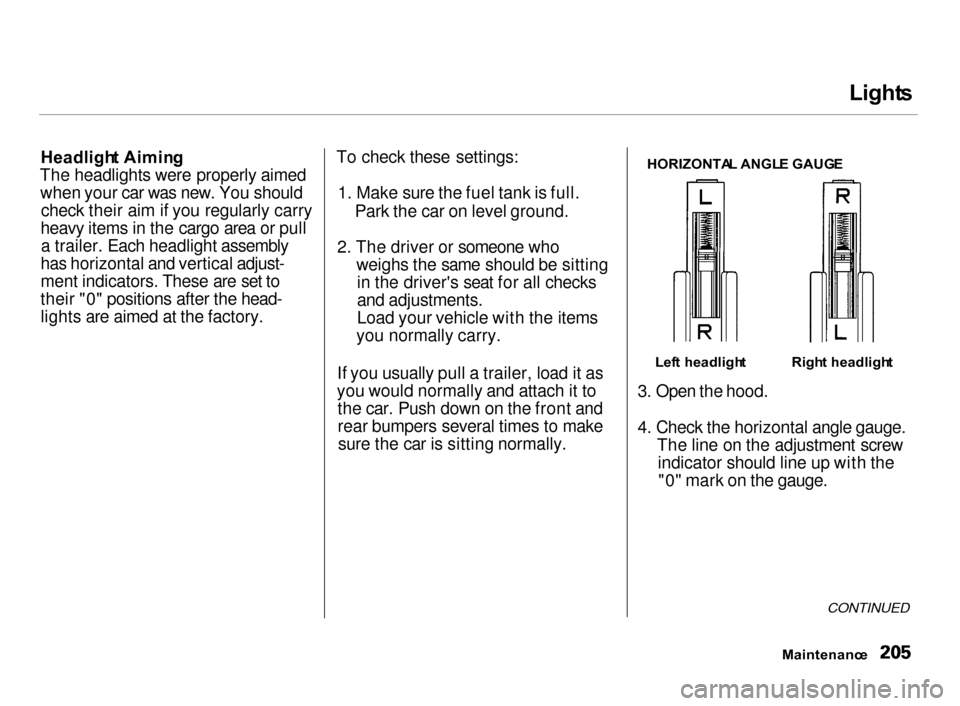
Light
s
Headligh t Aimin g
The headlights were properly aimed when your car was new. You should check their aim if you regularly carry
heavy items in the cargo area or pull a trailer. Each headlight assembly
has horizontal and vertical adjust-
ment indicators. These are set to
their "0" positions after the head-
lights are aimed at the factory. To check these settings:
1. Make sure the fuel tank is full.
Park the car on level ground.
2. The driver or someone who
weighs the same should be sitting in the driver's seat for all checks
and adjustments.
Load your vehicle with the items
you normally carry.
If you usually pull a trailer, load it as
you would normally and attach it to the car. Push down on the front and
rear bumpers several times to makesure the car is sitting normally. 3. Open the hood.
4. Check the horizontal angle gauge.
The line on the adjustment screw
indicator should line up with the"0" mark on the gauge.
CONTINUED
Maintenanc e
HORIZONTA
L ANGL E GAUG E
Lef t headligh t
Right headligh t
Page 217 of 279
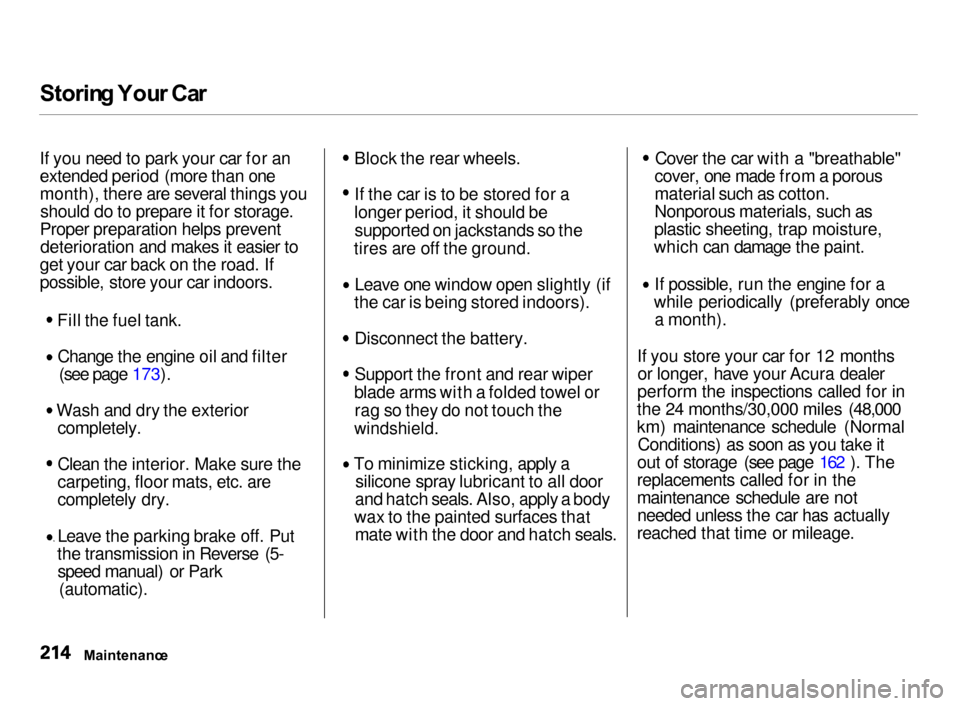
Storin
g You r Ca r
If you need to park your car for an
extended period (more than one
month), there are several things you should do to prepare it for storage.
Proper preparation helps prevent deterioration and makes it easier to
get your car back on the road. If
possible, store your car indoors.
Fill the fuel tank.Change the engine oil and filter (see page 173). Wash and dry the exterior
completely.
Clean the interior. Make sure the
carpeting, floor mats, etc. are
completely dry.
Leave the parking brake off. Put
the transmission in Reverse (5- speed manual) or Park (automatic). Block the rear wheels.
If the car is to be stored for a
longer period, it should be supported on jackstands so the
tires are off the ground. Leave one window open slightly (if
the car is being stored indoors). Disconnect the battery.
Support the front and rear wiper
blade arms with a folded towel or rag so they do not touch the
windshield.
To minimize sticking, apply a
silicone spray lubricant to all door
and hatch seals. Also, apply a body
wax to the painted surfaces that mate with the door and hatch seals. Cover the car with a "breathable"
cover, one made from a porous
material such as cotton.
Nonporous materials, such as
plastic sheeting, trap moisture,
which can damage the paint. If possible, run the engine for a
while periodically (preferably once a month).
If you store your car for 12 months or longer, have your Acura dealer
perform the inspections called for in
the 24 months/30,000 miles (48,000
km) maintenance schedule (Normal Conditions) as soon as you take it
out of storage (see page 162 ). The
replacements called for in the
maintenance schedule are not needed unless the car has actually
reached that time or mileage.
Maintenanc e
Page 234 of 279
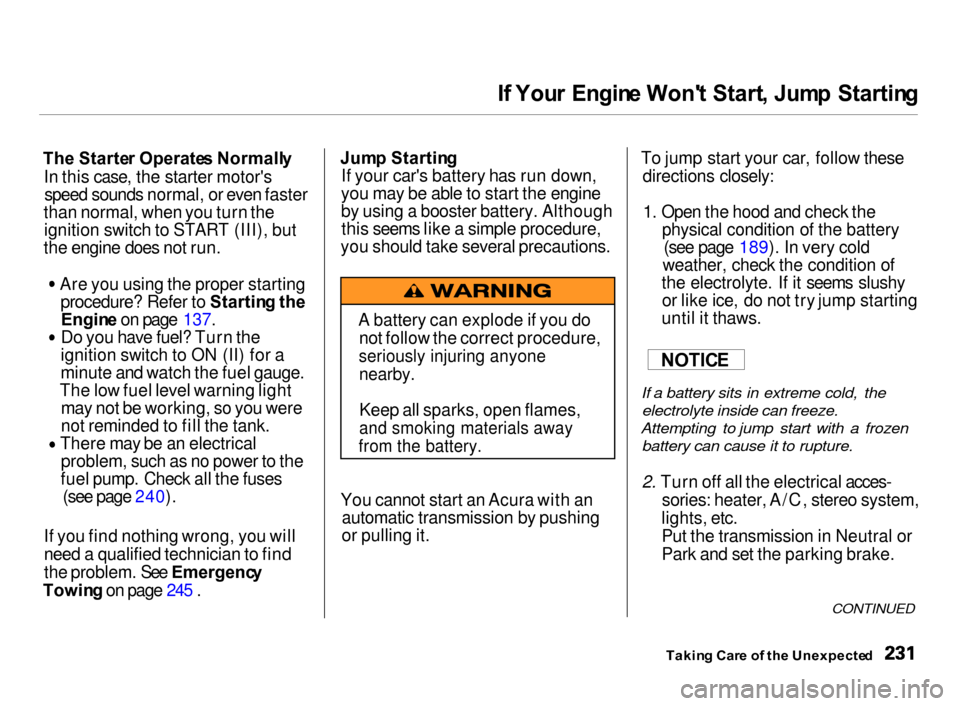
I
f You r Engin e Won' t Start , Jum p Startin g
Th e Starte r Operate s Normall y
In this case, the starter motor's speed sounds normal, or even faster
than normal, when you turn the ignition switch to START (III), but
the engine does not run. Are you using the proper starting
procedure? Refer to Startin g th e
Engin e on page 137. Do you have fuel? Turn the
ignition switch to ON (II) for a
minute and watch the fuel gauge.
The low fuel level warning light may not be working, so you were
not reminded to fill the tank. There may be an electrical
problem, such as no power to the
fuel pump. Check all the fuses (see page 240).
If you find nothing wrong, you will
need a qualified technician to find
the problem. See Emergenc y
Towin g on page 245 . Jum
p Startin g
If your car's battery has run down,
you may be able to start the engine
by using a booster battery. Although this seems like a simple procedure,
you should take several precautions.
You cannot start an Acura with an automatic transmission by pushing
or pulling it. To jump start your car, follow these
directions closely:
1. Open the hood and check the
physical condition of the battery(see page 189). In very cold
weather, check the condition of
the electrolyte. If it seems slushy or like ice, do not try jump starting
until it thaws.
If a battery sits in extreme cold, the
electrolyte inside can freeze.
Attempting to jump start with a frozen battery can cause it to rupture.
2. Turn off all the electrical acces-
sories: heater, A/C, stereo system,
lights, etc.
Put the transmission in Neutral or
Park and set the parking brake.
CONTINUED
Takin g Car e o f th e Unexpecte d
NOTIC
E
A battery can explode if you do
not follow the correct procedure,
seriously injuring anyone
nearby.
Keep all sparks, open flames,
and smoking materials away
from the battery.
Page 240 of 279

Malfunctio
n Indicato r Lam p
MALFUNCTIO N INDICATO R LAM P
This indicator comes on for a few seconds when you turn the ignition
switch ON (II). If it comes on at any
other time, it indicates one of the
engine's emissions control systems
may have a problem. Even though
you may feel no difference in your car's performance, it can reduce
your fuel economy and cause your car to put out excessive emissions.Continued operation may cause
serious damage. If you have recently refueled your
car, the cause of this indicator
coming on could be a loose or
missing fuel fill cap. Check the cap
and tighten it until it clicks several
times. Replace the fuel fill cap if it is
missing. Tightening the cap will not
make the indicator turn off
immediately; it takes three driving
trips.
If the indicator remains on past three
driving trips, or the fuel cap was not
loose or missing, have the car checked by the dealer as soon as
possible. Drive moderately until the dealer has inspected the problem.
Avoid full-throttle acceleration and driving at high speed. You should also have the dealer
inspect your car if this indicator
comes on repeatedly, even though it
may turn off as you continue driving.
If you keep driving with the malfunction indicator lamp on, you can
damage your car's emissions controls
and engine. Those repairs may not be
covered by your car's warranties.
Takin g Car e o f th e Unexpecte d
NOTIC
E
Page 250 of 279
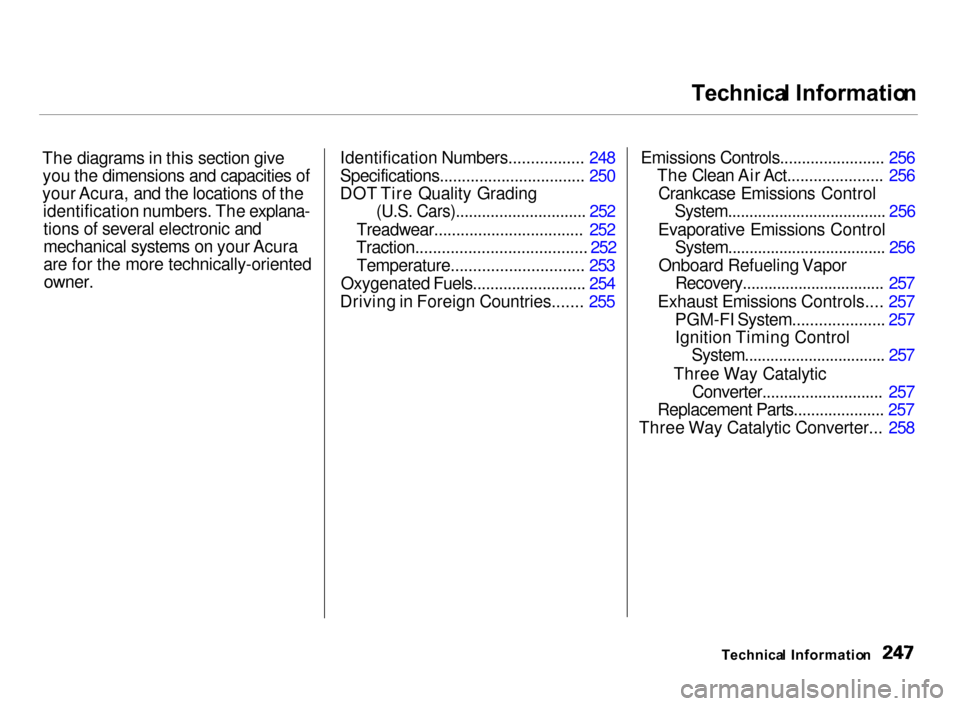
Technica
l Informatio n
The diagrams in this section give you the dimensions and capacities of
your Acura, and the locations of the identification numbers. The explana-tions of several electronic and
mechanical systems on your Acura
are for the more technically-oriented
owner.
Identification Numbers................. 248
Specifications................................. 250
DOT Tire Quality Grading
(U.S. Cars).............................. 252
Treadwear.................................. 252
Traction....................................... 252
Temperature.............................. 253
Oxygenated Fuels.......................... 254
Driving in Foreign Countries....... 255 Emissions Controls........................ 256
The Clean Air Act...................... 256
Crankcase Emissions Control
System..................................... 256
Evaporative Emissions Control
System..................................... 256
Onboard Refueling Vapor Recovery................................. 257
Exhaust Emissions Controls.... 257 PGM-FI System..................... 257
Ignition Timing Control
System................................. 257
Three Way Catalytic Converter............................ 257
Replacement Parts..................... 257
Three Way Catalytic Converter... 258
Technical Informatio n
Page 257 of 279
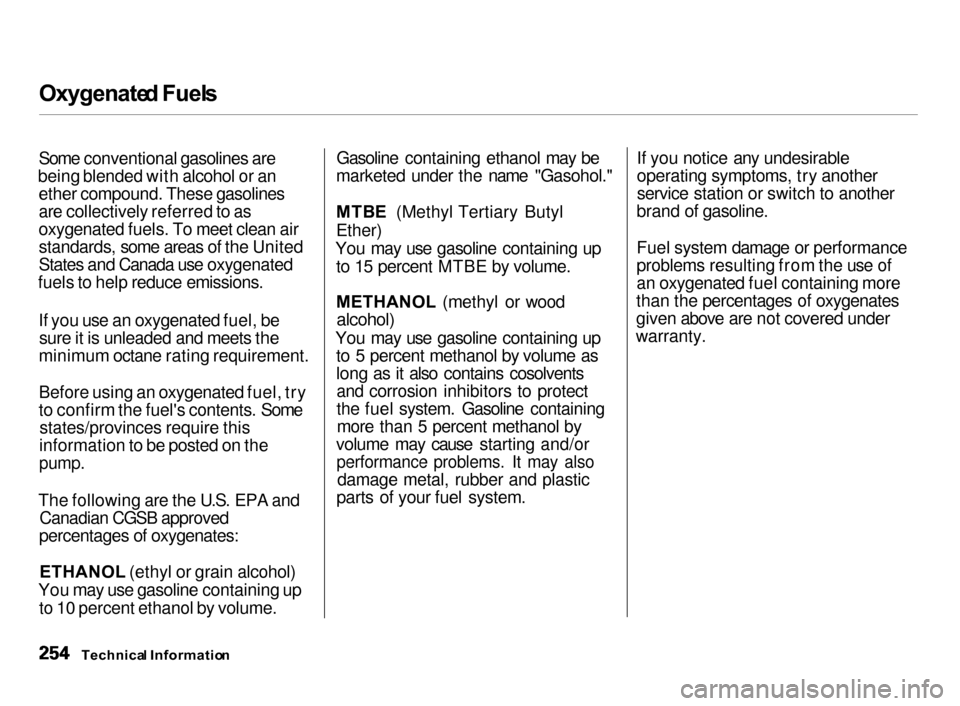
Oxygenate
d Fuel s
Some conventional gasolines are
being blended with alcohol or an ether compound. These gasolines
are collectively referred to as
oxygenated fuels. To meet clean air
standards, some areas of the United
States and Canada use oxygenated
fuels to help reduce emissions.
If you use an oxygenated fuel, besure it is unleaded and meets the
minimum octane rating requirement.
Before using an oxygenated fuel, try
to confirm the fuel's contents. Some states/provinces require this
information to be posted on the
pump.
The following are the U.S. EPA and Canadian CGSB approved
percentages of oxygenates:
ETHANOL (ethyl or grain alcohol)
You may use gasoline containing up to 10 percent ethanol by volume. Gasoline containing ethanol may be
marketed under the name "Gasohol."
MTB E (Methyl Tertiary Butyl
Ether)
You may use gasoline containing up to 15 percent MTBE by volume.
METHANOL (methyl or wood
alcohol)
You may use gasoline containing up to 5 percent methanol by volume as
long as it also contains cosolventsand corrosion inhibitors to protect
the fuel system. Gasoline containingmore than 5 percent methanol by
volume may cause starting and/orperformance problems. It may also
damage metal, rubber and plastic
parts of your fuel system. If you notice any undesirable
operating symptoms, try another
service station or switch to another
brand of gasoline.
Fuel system damage or performance
problems resulting from the use of
an oxygenated fuel containing more
than the percentages of oxygenates
given above are not covered under
warranty.
Technica l Informatio n
Page 258 of 279
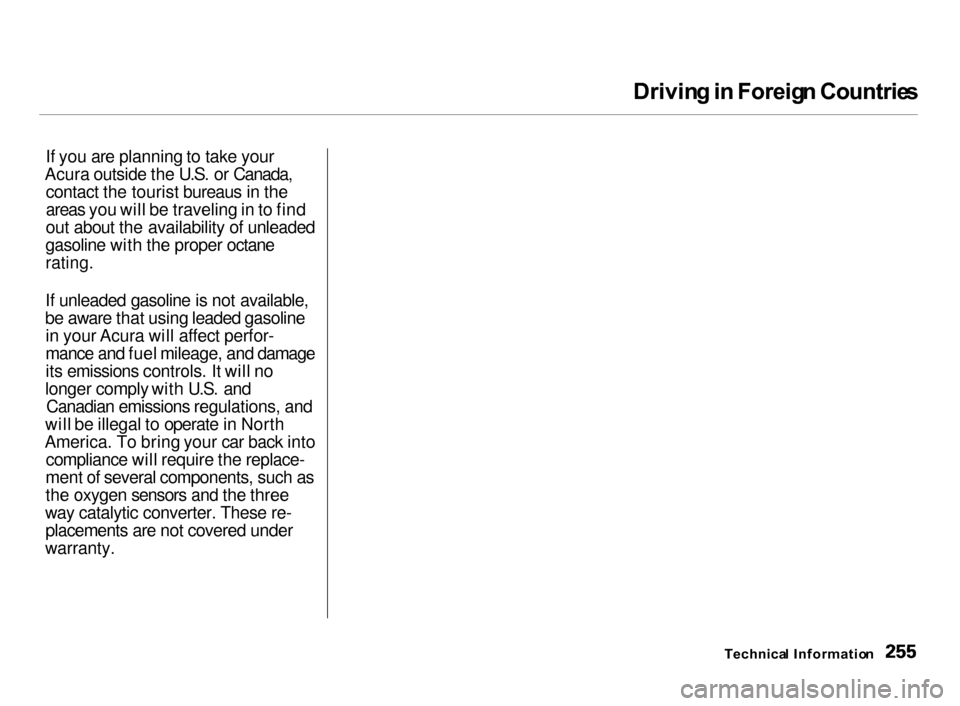
Drivin
g in Foreig n Countrie s
Technica l Informatio n
If you are planning to take your
Acura outside the U.S. or Canada, contact the tourist bureaus in the
areas you will be traveling in to find
out about the availability of unleaded
gasoline with the proper octane
rating.
If unleaded gasoline is not available,
be aware that using leaded gasoline in your Acura will affect perfor-
mance and fuel mileage, and damage
its emissions controls. It will no
longer comply with U.S. and Canadian emissions regulations, and
will be illegal to operate in North
America. To bring your car back into compliance will require the replace-
ment of several components, such as
the oxygen sensors and the three
way catalytic converter. These re- placements are not covered under
warranty.
Page 259 of 279
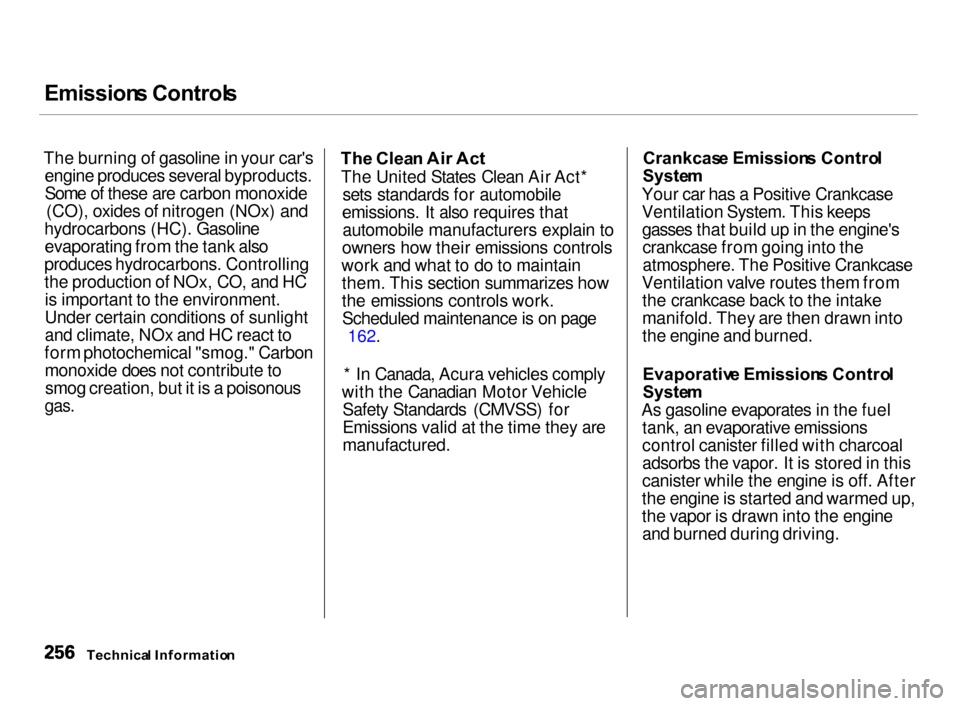
Emission
s Control s
The burning of gasoline in your car's engine produces several byproducts.
Some of these are carbon monoxide (CO), oxides of nitrogen (NOx) and
hydrocarbons (HC). Gasoline evaporating from the tank also
produces hydrocarbons. Controlling
the production of NOx, CO, and HC is important to the environment.
Under certain conditions of sunlight
and climate, NOx and HC react to
form photochemical "smog." Carbon monoxide does not contribute tosmog creation, but it is a poisonous
gas.
Th
e Clea n Ai r Ac t
The United States Clean Air Act* sets standards for automobile
emissions. It also requires that automobile manufacturers explain to
owners how their emissions controls
work and what to do to maintain them. This section summarizes how
the emissions controls work.Scheduled maintenance is on page
162.
* In Canada, Acura vehicles comply
with the Canadian Motor Vehicle Safety Standards (CMVSS) for
Emissions valid at the time they are
manufactured. Crankcas
e Emission s Contro l
Syste m
Your car has a Positive Crankcase
Ventilation System. This keeps gasses that build up in the engine'scrankcase from going into the
atmosphere. The Positive Crankcase
Ventilation valve routes them from the crankcase back to the intake
manifold. They are then drawn into
the engine and burned.
Evaporativ e Emission s Contro l
Syste m
As gasoline evaporates in the fuel tank, an evaporative emissions
control canister filled with charcoal
adsorbs the vapor. It is stored in this
canister while the engine is off. After
the engine is started and warmed up,
the vapor is drawn into the engine and burned during driving.
Technica l Informatio n
Page 260 of 279
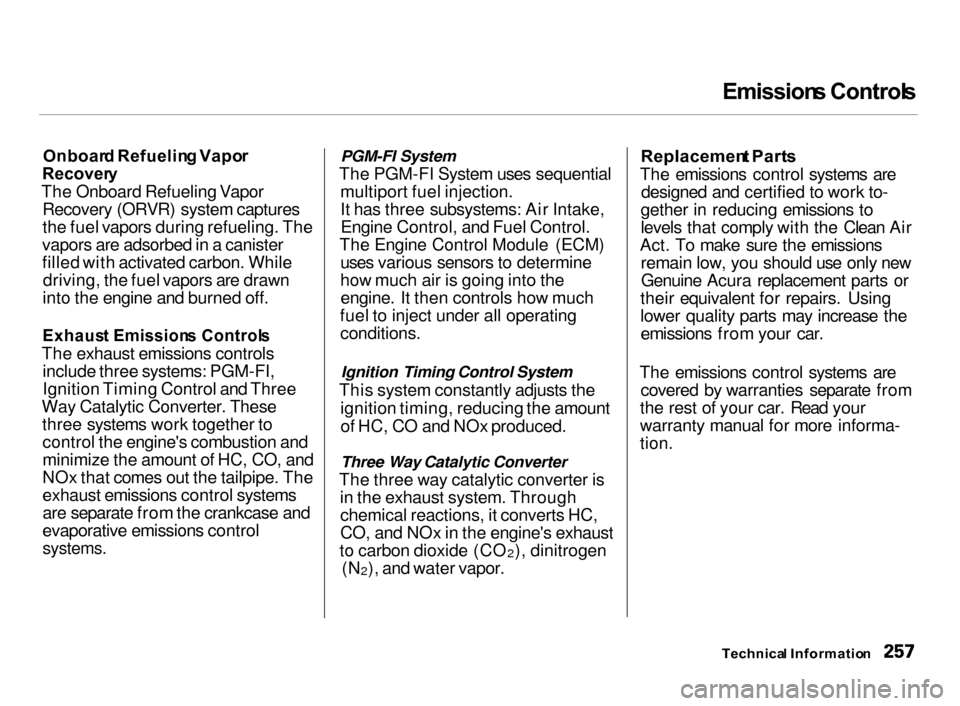
Emission
s Control s
Onboar d Refuelin g Vapo r
Recover y
The Onboard Refueling Vapor Recovery (ORVR) system captures
the fuel vapors during refueling. The
vapors are adsorbed in a canister
filled with activated carbon. While driving, the fuel vapors are drawn
into the engine and burned off.
Exhaus t Emission s Control s
The exhaust emissions controls include three systems: PGM-FI,
Ignition Timing Control and Three
Way Catalytic Converter. These three systems work together tocontrol the engine's combustion and
minimize the amount of HC, CO, and
NOx that comes out the tailpipe. The
exhaust emissions control systems
are separate from the crankcase and
evaporative emissions control
systems.
PGM-FI System
The PGM-FI System uses sequential multiport fuel injection.
It has three subsystems: Air Intake,Engine Control, and Fuel Control.
The Engine Control Module (ECM) uses various sensors to determine
how much air is going into theengine. It then controls how much
fuel to inject under all operating conditions.
Ignition Timing Control System
This system constantly adjusts the ignition timing, reducing the amountof HC, CO and NOx produced.
Three Way Catalytic Converter
The three way catalytic converter is in the exhaust system. Throughchemical reactions, it converts HC,
CO, and NOx in the engine's exhaust
to carbon dioxide (CO 2), dinitrogen
(N 2), and water vapor. Replacemen
t Part s
The emissions control systems are designed and certified to work to-
gether in reducing emissions to
levels that comply with the Clean Air
Act. To make sure the emissions remain low, you should use only newGenuine Acura replacement parts or
their equivalent for repairs. Using
lower quality parts may increase the emissions from your car.
The emissions control systems are covered by warranties separate from
the rest of your car. Read your
warranty manual for more informa-
tion.
Technical Informatio n
Page 272 of 279
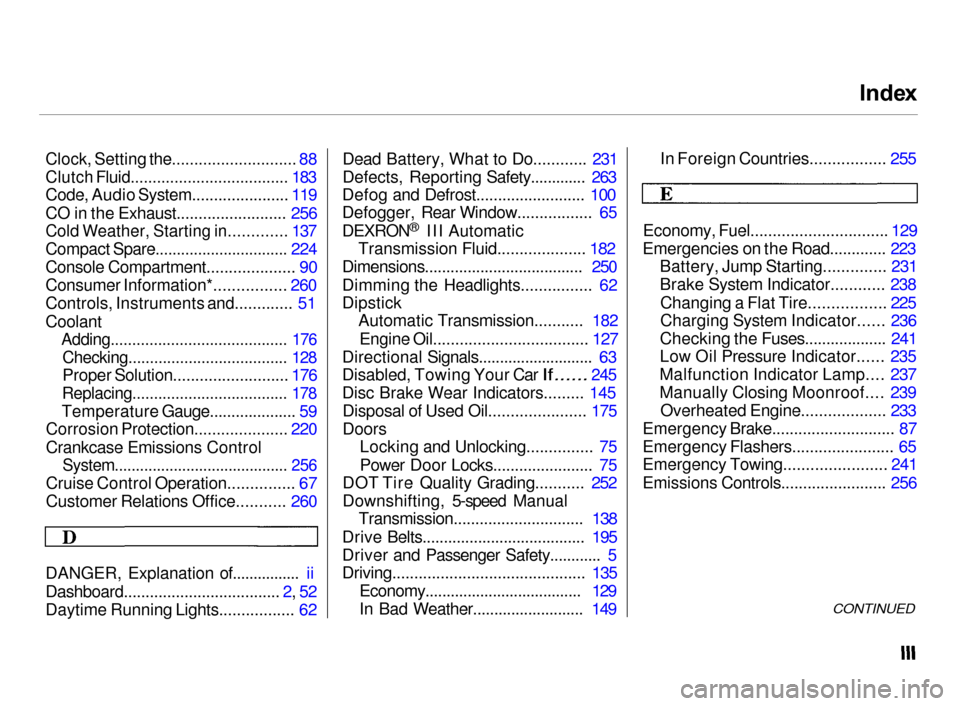
Inde
x
Clock, Setting the............................ 88
Clutch Fluid.................................... 183
Code, Audio System...................... 119
CO in the Exhaust......................... 256
Cold Weather, Starting in............. 137
Compact Spare............................... 224
Console Compartment.................... 90
Consumer Information*................ 260
Controls, Instruments and............. 51
Coolant
Adding......................................... 176
Checking..................................... 128
Proper Solution.......................... 176
Replacing.................................... 178
Temperature Gauge.................... 59
Corrosion Protection..................... 220
Crankcase Emissions Control
System......................................... 256
Cruise Control Operation............... 67
Customer Relations Office........... 260
DANGER, Explanation of................
ii
Dashboard.................................... 2, 52
Daytime Running Lights................. 62 Dead Battery, What to Do............ 231
Defects, Reporting Safety............. 263
Defog and Defrost......................... 100
Defogger, Rear Window................. 65
DEXRON ®
III Automatic
Transmission Fluid.................... 182
Dimensions..................................... 250
Dimming the Headlights................ 62
Dipstick Automatic Transmission........... 182
Engine Oil................................... 127
Directional Signals........................... 63
Disabled, Towing Your Car
If......
245
Disc Brake Wear Indicators......... 145 Disposal of Used Oil...................... 175
Doors Locking and Unlocking............... 75
Power Door Locks....................... 75
DOT Tire Quality Grading........... 252
Downshifting, 5-speed Manual Transmission.............................. 138
Drive Belts...................................... 195
Driver and Passenger Safety............ 5
Driving............................................ 135 Economy..................................... 129
In Bad Weather.......................... 149 In Foreign Countries................. 255
Economy, Fuel............................... 129
Emergencies on the Road............. 223 Battery, Jump Starting.............. 231
Brake System Indicator............ 238
Changing a Flat Tire................. 225
Charging System Indicator...... 236
Checking the Fuses................... 241
Low Oil Pressure Indicator...... 235
Malfunction Indicator Lamp.... 237
Manually Closing Moonroof.... 239 Overheated Engine................... 233
Emergency Brake............................ 87
Emergency Flashers....................... 65
Emergency Towing....................... 241
Emissions Controls........................ 256
CONTINUED